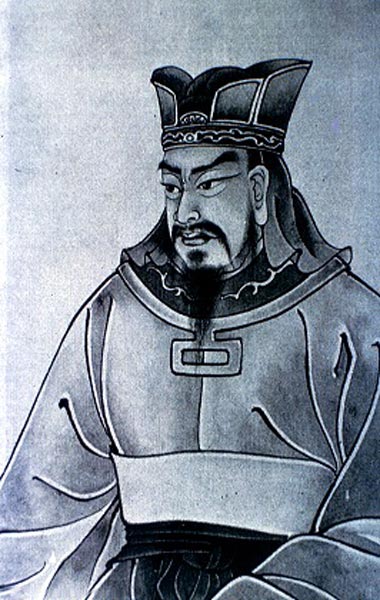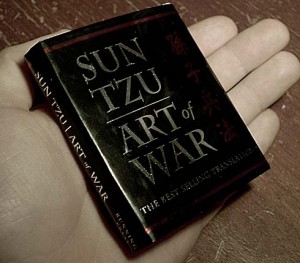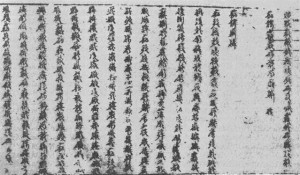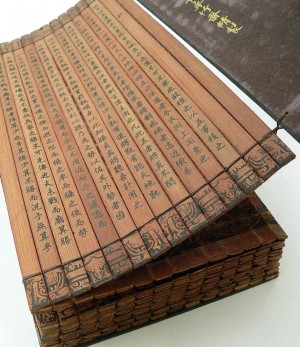| Sun Tzu | |
|---|---|
 |
|
| Chinese Military Strategist | |
| Born | c. 544 BC (traditional) |
| Died | c. 496 BC (traditional) |
| Nationality | Chinese |
| Era | Warring States |
| Work | The Art of War |
Sun Tzu (c. 544-496 BC) was a Chinese military expert and philosopher. Historians claim that he authored the book The Art of War, one of the most recognized treatises today on war strategies. His ideas were very influential and served to draw together seven warring nations of ancient eastern China: Zhao, Qi, Qin, Chu, Han, Wei and Yan.
Sun Tzu was also one of the great fathers of Chinese history and culture. He was born in late spring in a region called Wu and records suggest that he served under the rule of King Helu who ruled its province. Although his impact on Chinese history is quite significant, Sun Tzu is frequently confused for Sun Bin who authored a book called Sun Bin’s The Art of War. Sun Bin is actually a descendant of Sun Tzu. Sun Tzu’s writing gained worldwide recognition in the 19th and 20th centuries, especially among Westerners who found Eastern warfare interesting.
Sun Tzu’s and the Chinese Army
When Sun Tzu joined to the Chinese army, he was trained rigorously. The emperor noticed right off that he was exceptional and immediately chose him for a special duty. The emperor commanded Sun to train a harem of 180 concubines into soldiers. He divided them into groups of ninety and began their training. The concubines, at first, ignored him. However, because of his tenacity and pride he ordered them to be executed. Sun Tzu appointed new officers into the force, thus replacing the women. He stunned everyone with his harsh treatment of the concubines.
The Art of War
The Art of War, also known as Sunzi Bing Fa, is a collection of strategies on tactical ways of conducting warfare and methods of winning battles. This book was discovered in 1972, preserved on bamboo slips. Many people have cited Sun’s text in modern literature. The Art of War is believed to be a part of the course of uniting China’s warring states. The book was so associated with the Chinese war bureaucracy that it was made a mandatory text for those who sought out any military post.
Language Barrier in its translation
 The book was initially written in ancient Chinese, but after its discovery in 1972, we now have copies written in English. However, translations have caused some particularly harsh controversies in certain countries. Various phrases in Chinese, translated to English, have lost their intended meaning. Notably, the book was written in the context of Taoist thought and practice. The book also narrates and gives instructions on military decision-making. Political leaders and businessmen alike look to The Art of War today and find the text very useful. In the book, Sun Tzu advocates for diplomacy and encourages rivaling countries to work together carefully for the purposes of popular solidarity and a healthy global economy.
The book was initially written in ancient Chinese, but after its discovery in 1972, we now have copies written in English. However, translations have caused some particularly harsh controversies in certain countries. Various phrases in Chinese, translated to English, have lost their intended meaning. Notably, the book was written in the context of Taoist thought and practice. The book also narrates and gives instructions on military decision-making. Political leaders and businessmen alike look to The Art of War today and find the text very useful. In the book, Sun Tzu advocates for diplomacy and encourages rivaling countries to work together carefully for the purposes of popular solidarity and a healthy global economy.
Critics of Sun Tzu
 Critics have questioned Sun Tzu’s authorship and suggest that it historically inaccurate. They also question whether or not Tzu really executed King Helu’s concubines. Nonetheless, Tzu’s book has inspired many people. In fact, The Art of War is said to have inspired Qin Shi Huang (221-246), the emperor that unified China in the Third Century BC. Tzu’s philosophy, particularly his emphasis on diplomacy, may have prompted the unification of China’s warring states.
Critics have questioned Sun Tzu’s authorship and suggest that it historically inaccurate. They also question whether or not Tzu really executed King Helu’s concubines. Nonetheless, Tzu’s book has inspired many people. In fact, The Art of War is said to have inspired Qin Shi Huang (221-246), the emperor that unified China in the Third Century BC. Tzu’s philosophy, particularly his emphasis on diplomacy, may have prompted the unification of China’s warring states.
Samurai warriors of Japan were also intrigued by Tzu’s masterpiece and were believed to have used it as a framework as they attempted to unite Japan’s states. The book’s content was used by Admiral Fleet-Togo Heihachiro in the early twentieth century when Japan defeated Russia in a naval battle. This was the first time a previously Third World country defeated a Western nation in battle
Sun Tzu and the Present Day
The book’s strategies have even made their way into the battles of the twentieth century. The Art of War is also said to have had particular influence on General Vo Nguyen Giap as his army forced French and American soldiers out from their occupation of Vietnam. Arguably, the war in the Persian Gulf was also shaped by Tzu’s treatise. The U.S. State Department and the military acknowledge The Art of War as a means to understanding diplomacy, defense, and tactical decision-making.
